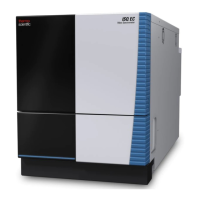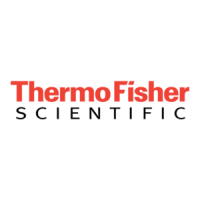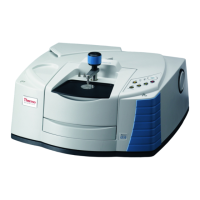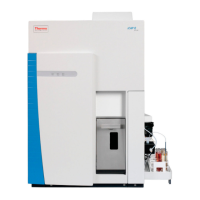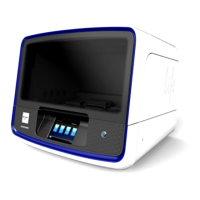Do you have a question about the Thermo Scientific ISQ and is the answer not in the manual?
An overview of the ISQ GC-MS system's capabilities and design.
Lists manuals and resources for the ISQ system and related software.
Details the hardware and software specifications needed for the ISQ data system.
Highlights essential safety information, warnings, and special notices in the guide.
Provides critical safety guidelines and precautions for using hydrogen gas.
Outlines safety measures for handling hazardous chemicals and biological materials.
Lists methods to contact Thermo Fisher Scientific for support and information.
Verifies that the ISQ system is powered on and the power indicator is lit.
Confirms that the carrier gas flow rate is set to the expected value.
Ensures adequate pressure in the carrier gas tank for sample runs.
Uses indicator lights to confirm proper vacuum and temperature levels.
Discusses column material, stationary phase, ID, film thickness, and length.
Provides step-by-step instructions for replacing the instrument's column.
Details the procedure for connecting a new column to the transfer line.
Describes how to open the ISQ Autotune window from the ISQ Dashboard.
Guides on selecting tune types and running the tuning process for optimal performance.
Explains how to configure method parameters for the autosampler.
Outlines steps to create an acquisition method for the ISQ mass spectrometer.
Details setting up GC oven parameters and injector settings for TRACE 1300/1310.
Explains how to configure GC oven parameters and injector settings for TRACE GC Ultra.
Covers setting up GC oven parameters and injector settings for the FOCUS GC.
Discusses the goals and methods for preparing samples for analysis.
Provides instructions on setting up and running a sequence of samples in Xcalibur.
Introduces the Qual Browser utility for viewing chromatograms and spectra.
Details how to open and select raw data files for analysis in Qual Browser.
Explains how to view and interpret chromatograms, including peak detection.
Covers adjusting mass ranges and identifying specific peaks for analysis.
Describes how to average spectra to improve signal quality and perform background subtraction.
Suggests adjustments to GC conditions to improve peak shape and resolution.
Offers methods to optimize sample introduction into the column for better results.
Provides guidance on sample preparation techniques to enhance analytical outcomes.
Explains how to adjust the scan rate for optimal chromatographic peak definition.
Discusses refining scan parameters to focus on specific compounds of interest.
Details setting the transfer line temperature to prevent column damage or compound loss.
Guides on customizing tune types to optimize system performance and tune parameters.
Lists potential causes and solutions when no ions are detected in scans.
Explains how to verify the installed firmware version for the ISQ instrument.
Identifies common indicators of contamination or issues requiring maintenance.
Provides a table of baseline behaviors, causes, and remedies for data analysis problems.
Offers solutions for common peak shape problems like broadening, fronting, and tailing.
Addresses problems related to low reproducibility, poor sensitivity, and retention time variations.
Outlines steps to reconfigure the ISQ instrument if communication is lost or software is reinstalled.
An overview of the ISQ GC-MS system's capabilities and design.
Lists manuals and resources for the ISQ system and related software.
Details the hardware and software specifications needed for the ISQ data system.
Highlights essential safety information, warnings, and special notices in the guide.
Provides critical safety guidelines and precautions for using hydrogen gas.
Outlines safety measures for handling hazardous chemicals and biological materials.
Lists methods to contact Thermo Fisher Scientific for support and information.
Verifies that the ISQ system is powered on and the power indicator is lit.
Confirms that the carrier gas flow rate is set to the expected value.
Ensures adequate pressure in the carrier gas tank for sample runs.
Uses indicator lights to confirm proper vacuum and temperature levels.
Discusses column material, stationary phase, ID, film thickness, and length.
Provides step-by-step instructions for replacing the instrument's column.
Details the procedure for connecting a new column to the transfer line.
Describes how to open the ISQ Autotune window from the ISQ Dashboard.
Guides on selecting tune types and running the tuning process for optimal performance.
Explains how to configure method parameters for the autosampler.
Outlines steps to create an acquisition method for the ISQ mass spectrometer.
Details setting up GC oven parameters and injector settings for TRACE 1300/1310.
Explains how to configure GC oven parameters and injector settings for TRACE GC Ultra.
Covers setting up GC oven parameters and injector settings for the FOCUS GC.
Discusses the goals and methods for preparing samples for analysis.
Provides instructions on setting up and running a sequence of samples in Xcalibur.
Introduces the Qual Browser utility for viewing chromatograms and spectra.
Details how to open and select raw data files for analysis in Qual Browser.
Explains how to view and interpret chromatograms, including peak detection.
Covers adjusting mass ranges and identifying specific peaks for analysis.
Describes how to average spectra to improve signal quality and perform background subtraction.
Suggests adjustments to GC conditions to improve peak shape and resolution.
Offers methods to optimize sample introduction into the column for better results.
Provides guidance on sample preparation techniques to enhance analytical outcomes.
Explains how to adjust the scan rate for optimal chromatographic peak definition.
Discusses refining scan parameters to focus on specific compounds of interest.
Details setting the transfer line temperature to prevent column damage or compound loss.
Guides on customizing tune types to optimize system performance and tune parameters.
Lists potential causes and solutions when no ions are detected in scans.
Explains how to verify the installed firmware version for the ISQ instrument.
Identifies common indicators of contamination or issues requiring maintenance.
Provides a table of baseline behaviors, causes, and remedies for data analysis problems.
Offers solutions for common peak shape problems like broadening, fronting, and tailing.
Addresses problems related to low reproducibility, poor sensitivity, and retention time variations.
Outlines steps to reconfigure the ISQ instrument if communication is lost or software is reinstalled.
| Type | Single Quadrupole Mass Spectrometer |
|---|---|
| Ion Source | Chemical Ionization (CI) |
| Resolution | Unit resolution |
| Interface | Liquid Chromatography (LC) |
| Detector | Electron Multiplier |
| Inlet | Direct Probe |
| Vacuum System | Turbomolecular pump |
